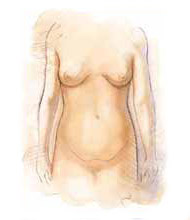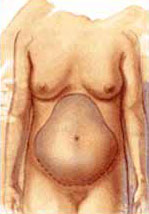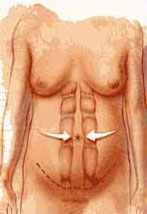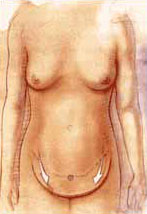|
ABDOMINOPLASTY or TUMMY TUCK
Women and men who have loose abdominal skin and fat that is concentrated in the abdomen can benefit from abdominoplasty. Sometimes these conditions are inherited. In other instances, substantial weight loss may cause abdominal skin to become flaccid. Abdominoplasty also can tighten muscles that have been separated and weakened by pregnancy. The procedure may somewhat improve the appearance of stretch marks, especially those located below the navel.
Your Personal Consultation
 During the consultation, you will be asked about the results you would like to achieve from abdominoplasty. This will help your surgeon to understand your expectations and determine whether they realistically can be achieved. During the consultation, you will be asked about the results you would like to achieve from abdominoplasty. This will help your surgeon to understand your expectations and determine whether they realistically can be achieved.
Am I a good candidate for abdominoplasty?
You may be a good candidate for abdominoplasty if you have one or more of the following conditions:
- excess or sagging abdominal skin
- an abdomen that protrudes and is out of proportion to the rest of your body
- abdominal muscles that have been separated and weakened
- excess fatty tissue that is concentrated in your abdomen
If you plan to become pregnant or lose weight in the future, you should discuss this with your plastic surgeon. Scarring from previous abdominal surgery may limit the results of your abdominoplasty.
How will my plastic surgeon evaluate me for abdominoplasty?
Your plastic surgeon may examine your abdomen while you are standing as well as lying down. Your skin tone and the degree of loose skin in the abdominal region will be assessed. Your surgeon also will evaluate the amount of excess fat in your abdomen and the condition of your abdominal muscles.
You should come to the consultation prepared to discuss your medical history. This will include information about any medical conditions, drug allergies, medical treatments you have received, pregnancies, previous surgeries and medications that you currently take. It is important for you to provide complete information.
How Abdominoplasty Is Performed
 Individual factors and personal preferences will determine the specific technique selected to smooth and flatten your abdomen. Individual factors and personal preferences will determine the specific technique selected to smooth and flatten your abdomen.
Where are the incisions placed?
Generally, a horizontal incision is placed just within or above the pubic area. The length of the incision, which extends laterally toward the pelvic bones, depends largely on the amount of skin to be removed. The contour of this incision will vary somewhat according to the structure of your abdomen and the style of bathing suit or undergarments that you prefer. Your plastic surgeon will try to keep the incision within your bathing suit lines, but this may not always be possible.
Generally, a horizontal incision is placed just within or above the pubic area. If there is loose skin above the navel, the surgeon may make a second incision around the navel. Skin in the shaded area is separated from the abdominal wall.
Some patients have loose skin above the navel. In such cases, the surgeon may make a second incision around the navel so that the redundant skin above it can be pulled down. The excess abdominal skin is then removed. The position of the navel remains unchanged.
 To tighten the abdominal wall, the surgeon brings loose underlying tissue and muscle together with sutures. To tighten the abdominal wall, the surgeon brings loose underlying tissue and muscle together with sutures.
Skin of the lower abdomen that contains stretch marks may be removed as well. Any remaining stretch marks may be somewhat flattened and improved, but you should not expect a dramatic change in their appearance.
Abdominal skin is pulled downward, and the excess is removed. A small opening is made to bring the navel through.
The procedure may include tightening of the underlying abdominal muscles using sutures.
What are some variations to the common abdominoplasty technique?
There are many variations both to the design of the incisions and the technique itself. In some instances, it may be possible to avoid an incision around the navel. When the amount of loose skin is minimal and the excess fat deposits are located below the navel, a short horizontal incision is all that is necessary. This procedure is called a partial, or "mini," abdominoplasty.
 Sometimes liposuction may be used alone, or in conjunction with abdominoplasty, to remove abdominal fat. Endoscopic abdominoplasty is another technique for minimizing scars and may be useful when patients have only a mild degree of excess fat and muscle laxity. Sometimes liposuction may be used alone, or in conjunction with abdominoplasty, to remove abdominal fat. Endoscopic abdominoplasty is another technique for minimizing scars and may be useful when patients have only a mild degree of excess fat and muscle laxity.
Your plastic surgeon will discuss with you the particular method that he or she recommends for achieving the best result in your particular case.
Understanding Risks
Fortunately, significant complications from abdominoplasty are infrequent. Every year, many thousands of people undergo successful aesthetic surgery of the abdomen, experience no major problems and are pleased with the results. Anyone considering surgery, however, should be aware of both the benefits and risks.
I understand that every surgical procedure has risks, but how will I learn more so that I can make an informed decision?
The subject of risks and potential complications of surgery is best discussed on a personal basis between you and your plastic surgeon, or with a staff member in your surgeon's office.
Some of the potential complications that may be discussed with you include bleeding, infection and reactions to anesthesia. Tissue loss along portions of the horizontal incision is a possibility when the abdominoplasty is very extensive. This complication, which delays healing and prolongs recovery, is more common in patients who smoke or have medical conditions such as diabetes. Revisionary surgery is sometimes helpful in certain instances where incisions may have healed poorly.
Following surgery, occasionally, fluid may accumulate under the skin. Removal of this serum is a painless process but may require several visits to the plastic surgeon's office.
You can help to lessen certain risks by following the advice and instructions of your plastic surgeon, both before and after surgery.
Your Surgical Experience
The goal of your plastic surgeon and the entire staff is to make your surgical experience as easy and comfortable for you as possible.
How should I prepare for surgery?
If you are a smoker, you will be asked to stop smoking well in advance of surgery. Aspirin and certain anti-inflammatory drugs can cause increased bleeding, so you should avoid taking these medications for a period of time before surgery. Your surgeon will provide you with additional preoperative instructions.
Abdominoplasty may be performed on an outpatient basis. If this is the case, be sure to arrange for someone to drive you home after surgery and to stay with you for at least the next day or two. When abdominoplasty is performed in conjunction with medically necessary procedures such as hysterectomy or hernia repair, a short hospitalization may be required.
What will the day of surgery be like?
Your abdominoplasty may be performed in a hospital, free-standing ambulatory facility or office-based surgical suite.
Medications are administered for your comfort during the surgical procedure. Often, a general anesthetic is administered, so that you will be asleep throughout the procedure. Abdominoplasty may be performed using local anesthesia and intravenous sedation. When surgery is completed, you will be taken into a recovery area where you will continue to be closely monitored. In many instances, small drain tubes will have been placed within the abdominal tissues to help avoid accumulation of fluids. Gauze or other dressings may be applied to your abdomen and covered with tape or an elastic bandage.
You may be permitted to go home after a few hours, unless you and your plastic surgeon have determined that you will stay in the hospital or surgical facility overnight.
How will I look and feel initially?
The day after surgery, you will be encouraged to get out of bed for short walks to promote blood circulation. Although you may not be able to stand up completely straight, it is best if you do not sit for long periods of time during the first several days. Straining, bending and lifting must be avoided, since these activities might cause increased swelling or even bleeding. You may be instructed to sleep on your back with a pillow under your knees.
Any surgical drains probably will be removed within a week following surgery, at which time your dressings may also be changed or removed. Depending on the abdominoplasty technique used, you may be instructed to wear a support garment for several weeks. Generally, stitches will be removed in stages over a period of approximately one or two weeks.
You will notice swelling and bruising, which is to be expected. The bruising and much of the swelling will disappear over a period of weeks. However, it may be months before all swelling subsides and you see the final result of your abdominoplasty. You may also notice some numbness over portions of the abdominal area, and this may persist for several months. Incisions will initially be red or pink in color. They will remain this way for many months following surgery and may even appear to worsen before they finally begin to fade.
When can I resume my normal activities?
It is important to realize that the amount of time it takes for recovery varies greatly among individuals. Depending on the extent of your abdominoplasty and your general physical condition, you may be able to return to non-strenuous work anywhere from one to three weeks after surgery. In many instances, you can resume most of your normal activities, including some form of mild exercise, after a few weeks. You may continue to experience some mild, periodic discomfort and swelling during this time, but such feelings are normal. Severe pain should be reported to your doctor.
Any sexual activity should be avoided for a minimum of two weeks, and your plastic surgeon may advise you to wait longer.
Results of Your Abdominoplasty
Abdominoplasty will enhance your body contour by making your abdomen firmer and flatter. You may find that you feel more comfortable in your clothing and are more confident about your appearance.
The incisions from the procedure will heal and fade over time. It is important to realize, however, that the incision lines will be permanently visible. In some instances, they will eventually be only faint lines. Certain individuals may have incision lines that are more noticeable. Fortunately, the incisions for your abdominoplasty are usually in locations concealed by most bathing suits and undergarments.
How long will the results last?
Unless you gain or lose a significant amount of weight or become pregnant, your abdomen should remain firmer and flatter for many years. However, gravity and the effects of aging will eventually take their toll. If, after a period of years, you again become dissatisfied with the appearance of your abdomen, you may choose to undergo a second procedure to restore a more youthful body contour.
|